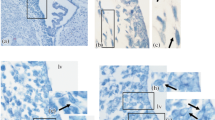Abstract—
Supraependymal plexus of the brain ventricles is one of the most mysterious structural formations in the central nervous system. Since both the topography of supraependymal elements and their functional significance remain unclear, the aim of this study was to study the distribution of supraependymal structures within the ventricular system of the rat brain with synaptic function associated marker, synaptophysin. Serial sections of Wistar rats forebrain (4–6 months, n = 6) were examined using immunohistochemical detection of synaptophysin and tyrosine hydroxylase. It was demonstrated that supraependymal structures form small discrete clusters on the apical surface of ependymocytes, which indicates synaptic contacts. Although catecholaminergic nerve fibers were present on the ventricular surface in all studied zones, it seems that these nerve fibers may not always contain synaptophysin. Thus, it is supposed that the functional purpose of the supraependymal nerve plexus depends on its localization and can be associated both with the regulation of the functional status of ependymal cells and the formation of the cerebrospinal fluid composition and with the formation of interneuronal synaptic communications.

Similar content being viewed by others
REFERENCES
Calhoun, M.E., Jucker, M., Martin, L.J., Thinakaran, G., Price, D.L., and Mouton, P.R., Comparative evaluation of synaptophysin-based methods for quantification of synapses, J. Neurocytol., 1996, vol. 25, p. 821. https://doi.org/10.1007/BF02284844
Chan-Palay, V., Serotonin axons in the supra- and subependymal plexuses and in the leptomeninges; their roles in local alterations of cerebrospinal fluid and vasomotor activity, Brain Res., 1976, vol. 102, p. 103. https://doi.org/10.1016/0006-8993(76)90578-3
Cupédo, R.N.J., The surface ultrastructure of the habenular complex of the rat, Anat. Embryol., 1977, vol. 152, p. 43. https://doi.org/10.1007/BF00341434
Cupédo, R.N.J. and de Weerd, H., Serotonergic intraventricular axons in the habenular region. Phagocytosis after induced degeneration, Anat. Embryol., 1980, vol. 158, p. 213. https://doi.org/10.1007/BF00315907
Haemmerle, C.A., Nogueira, M.I., and Watanabe, I.S., The neural elements in the lining of the ventricular-subventricular zone: making an old story new by high-resolution scanning electron microscopy, Front. Neuroanat., 2015, vol. 9. https://doi.org/10.3389/FNANA.2015.00134
Hámori, J. and Somogyi, J., Differentiation of cerebellar mossy fiber synapses in the rat: a quantitative electron microscope study, J. Comp. Neurol., 1983, vol. 220, p. 365. https://doi.org/10.1002/CNE.902200402
Janz, R., Südhof, T.C., Hammer, R.E., Unni, V., Siegelbaum, S.A., and Bolshakov, V.Y., Essential roles in synaptic plasticity for synaptogyrin I and synaptophysin I, Neuron, 1999, vol. 24, p. 687. https://doi.org/10.1016/S0896-6273(00)81122-8
Kolos, E.A., Grigoriyev, I.P., and Korzhevskiy, D.E., A synaptic marker synaptophysin, Morphologija, 2015, vol. 147, no. 1, p. 78.
Korzhevskii, D.E., Sukhorukova, E.G., Kirik, O.V., and Grigorev, I.P., Immunohistochemical demonstration of specific antigens in the human brain fixed in zinc–ethanol–formaldehyde, Eur. J. Histochem., 2015, vol. 59, p. 5. https://doi.org/10.4081/EJH.2015.2530
Martínez, P.M. and de Weerd, H., The fine structure of the ependymal surface of the recessus infundibularis in the rat, Anat. Embryol., 1977, vol. 151, p. 241. https://doi.org/10.1007/BF00318929
Møllgård, K. and Wiklund, L., Serotoninergic synapses on ependymal and hypendymal cells of the rat subcommissural organ, J. Neurocytol., 1979, vol. 8, p. 445. https://doi.org/10.1007/BF01214802
Mullier, A., Bouret, S.G., Prevot, V., and Dehouck, B., Differential distribution of tight junction proteins suggests a role for tanycytes in blood-hypothalamus barrier regulation in the adult mouse brain, J. Comp. Neurol., 2010, vol. 518, p. 943. https://doi.org/10.1002/CNE.22273
Murtazina, A.R., Bondarenko, N.S., Pronina, T.S., Chandran, K.I., Bogdanov, V.V., Dilmukhametova, L.K., and Ugrumov, M.V., A comparative analysis of CSF and the blood levels of monoamines as neurohormones in rats during ontogenesis, Acta Naturae, 2021, vol. 13, no. 4, p. 89. https://doi.org/10.32607/actanaturae.11516
Navone, F., Jahn, R., Di Gioia, G., Stukenbrok, H., Greengard, P., and De Camilli, P., Protein p38: an integral membrane protein specific for small vesicles of neurons and neuroendocrine cells, J. Cell Biol., 1986, vol. 103, p. 2511. https://doi.org/10.1083/JCB.103.6.2511
Page, R.B., Anatomy of the hypothalamo-hypophysial complex, in Physiology of Reproduction, Academic Press, 2006.
Rabey, J.M. and Hefti, F., Neuromelanin synthesis in rat and human substantia nigra, J. Neural Transm.: Parkinson’s Dis. Dementia Sect., 1990, vol. 2, p. 1. https://doi.org/10.1007/BF02251241
Richards, J.G., Lorez, H.P., Colombo, V.E., Guggenheim, R., Kiss, D., and Wu, J.Y., Demonstration of supra-ependymal 5-HT nerve fibres in human brain and their immunohistochemical identification in rat brain, J. Physiol. (Paris), 1981, vol. 77, p. 219.
Sufieva, D.A., Kirik, O.V., and Korzhevskii, D.E., Astrocyte markers in the tanycytes of the third brain ventricle in postnatal development and aging in rats, Russ. J. Dev. Biol., 2019, vol. 50, p. 146. https://doi.org/10.1134/S1062360419030068
Tong, C.K., Chen, J., Cebrián-Silla, A., Mirzadeh, Z., Obernier, K., Guinto, C.D., Tecott, L.H., García-Verdugo, J.M., Kriegstein, A., and Alvarez-Buylla, A., Axonal control of the adult neural stem cell niche, Cell Stem Cell, 2014, vol. 14, p. 500. https://doi.org/10.1016/J.STEM.2014.01.014
Troshev, D., Bannikova, A., Blokhin, V., Kolacheva, A., Pronina, T., and Ugrumov, M., Striatal neurons partially expressing a dopaminergic phenotype: functional significance and regulation, Int. J. Mol. Sci., 2022, vol. 23. https://doi.org/10.3390/IJMS231911054/S1
Ugryumov, M.V., Endocrine functions of brain in adult and developing mammals, Russ. J. Dev. Biol., 2009, vol. 40, no. 1, p. 14.
Funding
This work was carried out within the framework of a state order to the Institute of Experimental Medicine.
Author information
Authors and Affiliations
Contributions
V.A. Razenkova: performing immunohistochemical staining, literature analysis, interpretation of the results, working with the illustrations, writing the article text. O.V. Kirik: design of the study planning, collection of biological material and paraffin embedding, photographing and analysis of preparations, editing of the manuscript.
Corresponding author
Ethics declarations
Conflict of interest. The authors declare that they have no conflicts of interest.
Statement on the welfare of animals. All applicable international guidelines for the care and use of animals were followed. The study was approved by the Local Ethics Committee of the Institute of Experimental Medicine (conclusion no. 2/22 dated April 6, 2022).
Additional information
Translated by A. Barkhash
Translated by I. Fridlyanskaya
Abbreviations: SVZ—subventricular zone; TH—tyrosine hydroxylase; CSF—cerebrospinal fluid.
Rights and permissions
About this article
Cite this article
Razenkova, V.A., Kirik, O.V. Synaptophysin Expression by Supraependymal Structures of Rat Brain. Cell Tiss. Biol. 17, 517–521 (2023). https://doi.org/10.1134/S1990519X23050115
Received:
Revised:
Accepted:
Published:
Issue Date:
DOI: https://doi.org/10.1134/S1990519X23050115



